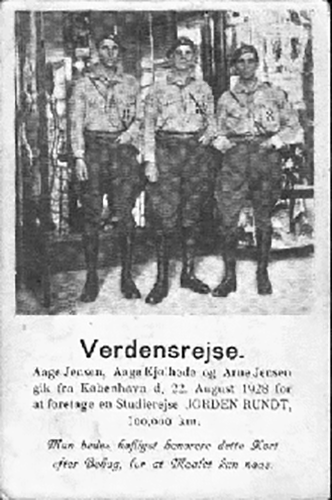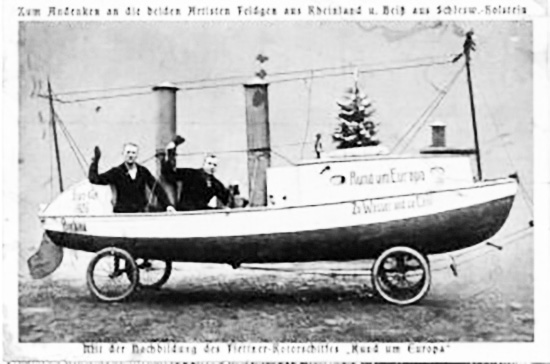- Alias-Pseudonimo-Pseudonyme: -
- Nationality-Nazionalità-Nationalité: Denmark, Danimarca
- Birth/death-Nascita/morte-Naissance/mort: -
- Means of transport-Mezzo di trasporto-Moyen de transport: -
- Geographical description-Riferimento geografico-Référence géographique: -
- Inscriptions-Iscrizioni-Inscriptions: Verdensrejse

.jpg)
- Alias-Pseudonimo-Pseudonyme: -
- Nationality-Nazionalità-Nationalité: -
- Birth/death-Nascita/morte-Naissance/mort: -
- Means of transport-Mezzo di trasporto-Moyen de transport: Wagon, Carro, Char
- Geographical description-Riferimento geografico-Référence géographique: Americas, Americhe, Amérique
- Inscriptions-Iscrizioni-Inscriptions: Pioneer Covered Wagon and Pony - Around the World
.jpg)
- Alias-Pseudonimo-Pseudonyme: -
- Nationality-Nazionalità-Nationalité: -
- Birth/death-Nascita/morte-Naissance/mort: -
- Means of transport-Mezzo di trasporto-Moyen de transport: On foot, A piedi, A pied
- Geographical description-Riferimento geografico-Référence géographique: Austria
- Inscriptions-Iscrizioni-Inscriptions: Zu Fuss zur I. arbeiter Olympiade Freital - Wien
.jpg)
- Alias-Pseudonimo-Pseudonyme: -
- Nationality-Nazionalità-Nationalité: -
- Birth/death-Nascita/morte-Naissance/mort: -
- Means of transport-Mezzo di trasporto-Moyen de transport: On foot, A piedi, A pied
- Geographical description-Riferimento geografico-Référence géographique: Europe, Europa
- Inscriptions-Iscrizioni-Inscriptions: Zu Fuss durch Europa!

- Alias-Pseudonimo-Pseudonyme: -
- Nationality-Nazionalità-Nationalité: Germany, Germania, Allemagne
- Birth/death-Nascita/morte-Naissance/mort: -
- Means of transport-Mezzo di trasporto-Moyen de transport: On foot, A piedi, A pied
- Geographical description-Riferimento geografico-Référence géographique: Europe, Europa
- Inscriptions-Iscrizioni-Inscriptions: Mit der Nachbildung des Flettner-Rotors "Rund um Europa"
.jpg)
- Alias-Pseudonimo-Pseudonyme: -
- Nationality-Nazionalità-Nationalité: -
- Birth/death-Nascita/morte-Naissance/mort: -
- Means of transport-Mezzo di trasporto-Moyen de transport: -
- Geographical description-Riferimento geografico-Référence géographique: Various, Diversi, Différents
- Inscriptions-Iscrizioni-Inscriptions: Im Faltboot nach dem Orient - In the fold-boat to the Orient - En cano jusqu'en Orient - Passau, Wien, Budapest, Schwarzes Meer, Konstantinopel
.jpg)
- Alias-Pseudonimo-Pseudonyme: -
- Nationality-Nazionalità-Nationalité: -
- Birth/death-Nascita/morte-Naissance/mort: -
- Means of transport-Mezzo di trasporto-Moyen de transport: Various, Diversi, Différents
- Geographical description-Riferimento geografico-Référence géographique: Europe, Europa
- Inscriptions-Iscrizioni-Inscriptions: Mit dem ältesten Auto von Holland: Quer durch Europa. Abfahrt von Rotterdam am 3.12.27. Zurückgelegt 54'000 km (28 Länder)
.jpg)
- Alias-Pseudonimo-Pseudonyme: -
- Nationality-Nazionalità-Nationalité: -
- Birth/death-Nascita/morte-Naissance/mort: -
- Means of transport-Mezzo di trasporto-Moyen de transport: On foot, A piedi, A pied
- Geographical description-Riferimento geografico-Référence géographique: Europe, Europa
- Inscriptions-Iscrizioni-Inscriptions: Berlin-Genf zu Fuss
.jpg)
- Alias-Pseudonimo-Pseudonyme: -
- Nationality-Nazionalità-Nationalité: Netherlands, Olanda, Hollande
- Birth/death-Nascita/morte-Naissance/mort: -
- Means of transport-Mezzo di trasporto-Moyen de transport: Bike, Bicicletta, Vélo
- Geographical description-Riferimento geografico-Référence géographique: Various, Diversi, Différents
.jpg)
- Alias-Pseudonimo-Pseudonyme: -
- Nationality-Nazionalità-Nationalité: -
- Birth/death-Nascita/morte-Naissance/mort: -
- Means of transport-Mezzo di trasporto-Moyen de transport: On foot, A piedi, A pied
- Geographical description-Riferimento geografico-Référence géographique: Asia
- Inscriptions-Iscrizioni-Inscriptions: Zur Erinnerung an meine Orientreise 1902
.jpg)
- Alias-Pseudonimo-Pseudonyme: -
- Nationality-Nazionalità-Nationalité: -
- Birth/death-Nascita/morte-Naissance/mort: -
- Means of transport-Mezzo di trasporto-Moyen de transport: On foot, A piedi, A pied
- Geographical description-Riferimento geografico-Référence géographique: Europe, Europa
- Inscriptions-Iscrizioni-Inscriptions: Eine fussreise durch Europa - To trot through Europe
.jpg)
- Alias-Pseudonimo-Pseudonyme: -
- Nationality-Nazionalità-Nationalité: -
- Birth/death-Nascita/morte-Naissance/mort: -
- Means of transport-Mezzo di trasporto-Moyen de transport: Bike, Bicicletta, Vélo
- Geographical description-Riferimento geografico-Référence géographique: Europe, Europa
- Inscriptions-Iscrizioni-Inscriptions: Tour d'Europe en trois ans en bicyclette - Vivre et laisser vivre! Déjà visité: Hollande, Belgique, France, Italie Après: Angleterre, Danemarck, Norvège, Suède, Allemagne, Suisse, Autriche, Hongrie, etc. Je vends cette carte pour mes frais
| Precursori, Forerunners, Précurseurs |
|---|
|
|
| Viaggi stravaganti, Weird travels, Voyages insolites |
|---|
|
|
| Globetrotter contemporanei, Contemporary globetrotters, Globetrotteurs contemporains |
|---|
|
|
| Personaggi fittizi, Fictional character, Personnages de fiction |
|---|
|
|
Impressum
Copyright 2016-2025 Museum of Travel and Tourism (MTT)
Source citation "Museum of Travel and Tourism, museumoftravel.org"
Info Developed by www.rhpositive.net. Logo: icons www.flaticon.com. Translations Openai ChatGPT. Images Midjourney and ChatGPT, unless otherwise specified

 IT
IT  FR
FR  DE
DE  EN
EN